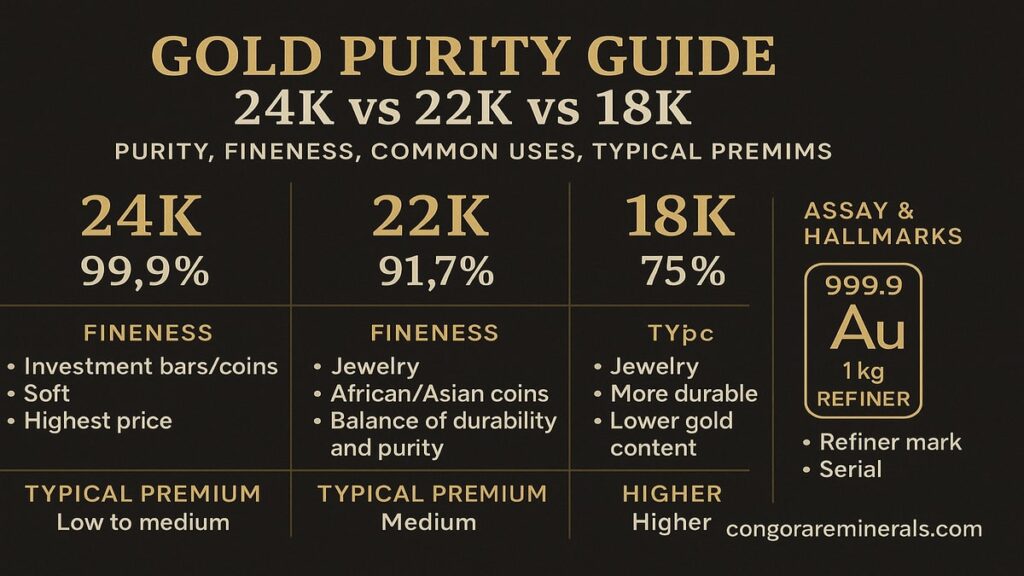If you’re new to buying gold, karats can feel confusing. Here’s a clear breakdown of purity, uses, and pricing so you can buy with confidence and resell without headaches.
The short version
- 24K is the purest. It’s the standard for investment bars and most investment coins.
- 23K sits between jewelry and investment. Good where high purity matters but you still want some hardness.
- 22K is common in jewelry because it’s tougher than 24K. Some famous investment coins are 22K yet still contain 1 troy ounce of pure gold by adding a small alloy to reach a higher gross weight.
Karats at a glance
| Karat | Fineness | % gold | Pure gold in 100 g | Pure gold in 1 oz troy (31.1035 g) |
|---|---|---|---|---|
| 24K | ~999–999.9 | 99.9% | 100.0000 g | 31.1035 g |
| 23K | ~958 | 95.833% | 95.8333 g | 29.8075 g |
| 22K | ~916 | 91.667% | 91.6667 g | 28.5115 g |
The math: Karat fraction = K/24. Example: 22K = 22/24 = 0.916667.
How each is used
24K (investment grade)
- Typical form: bars and many investment coins.
- Why buyers choose it: maximum purity, easiest to price against spot, favored for long-term vaulting and international transfers.
- Handling: soft and malleable, so protect it from scratches.
23K (high-purity jewelry and niche investment)
- Typical form: select jewelry and regional bullion.
- Why buyers choose it: very high purity with a little more hardness than 24K.
- Handling: still soft; treat like 24K for storage.
22K (jewelry and some coins)
- Typical form: jewelry, bangles, and several world coins.
- Why buyers choose it: better scratch resistance than 24K with high gold content.
- Important note: some 22K coins are engineered to contain exactly 1 oz of fine gold. They add a small amount of copper/silver so the total coin weight is higher than 1 oz while the fine content is still 1 oz.
Pricing basics you can use
- Spot value is for pure gold.
To estimate intrinsic value, multiply the gross weight by the karat fraction (K/24), then by spot price per gram or per kg. - Examples at a sample spot of $75,000 per kg
- 100 g 24K: 0.1000 kg × $75,000 = $7,500
- 100 g 23K: 0.1000 × (23/24) × $75,000 = $7,187.50
- 100 g 22K: 0.1000 × (22/24) × $75,000 = $6,875.00
- Premiums
- Smaller pieces and premium brands cost more over spot.
- Minted bars and carded presentation raise premiums.
- Larger cast bars (250 g, 1 kg) usually have the lowest cost per gram.
- Total cost matters
Add shipping, insurance, assay, and any duties or taxes at destination.
Authenticity and verification
Use a layered approach:
- Paper trail: pro-forma and final invoice, assay card/report, certificate of origin (where applicable), insurance, airway bill, and for bars a serial-numbered bar list.
- Physical checks: weight, dimensions, finish, hallmark, and serial consistency. Gold is non-magnetic.
- Instrument tests: XRF for surface composition, eddy-current or ultrasound for internal consistency. Fire assay is definitive but destructive and used when needed.
Need independent testing or a buyer-nominated refinery check before settlement? We can coordinate via /lab-testing/ and /service/refining/.
Which karat should you buy?
- Long-term investment bars or coins: 24K is the simplest to price and move globally.
- Daily-wear jewelry with strong resale value: 22K is a practical balance of purity and toughness.
- High-purity jewelry or regional preference: 23K is a solid middle ground.
Tip: for investments, stick to standard units that quote easily: 1 oz coins, 100 g, 250 g, and 1 kg bars.
Storage and resale pointers
- Store larger holdings in a professional depository; keep a small reserve at home only if you have a real safe and insurance.
- Keep every document together. Buyers pay faster and better when your paperwork is clean.
- Big bars can require third-party verification to get the best bid. Plan for that step if you favor 1 kg bars.
How Congo Rare Minerals helps
- 22K, 23K, and 24K options available with a 100 g minimum order.
- Insured export to approved destinations.
- Verification support at your nominated refinery where required.
- A clear, written documents pack for each shipment.
Ready to compare live options
- Shop: /shop/
- Testing: /lab-testing/
- Refining & documentation: /service/refining/
- Speak to sales: /contact-us/

